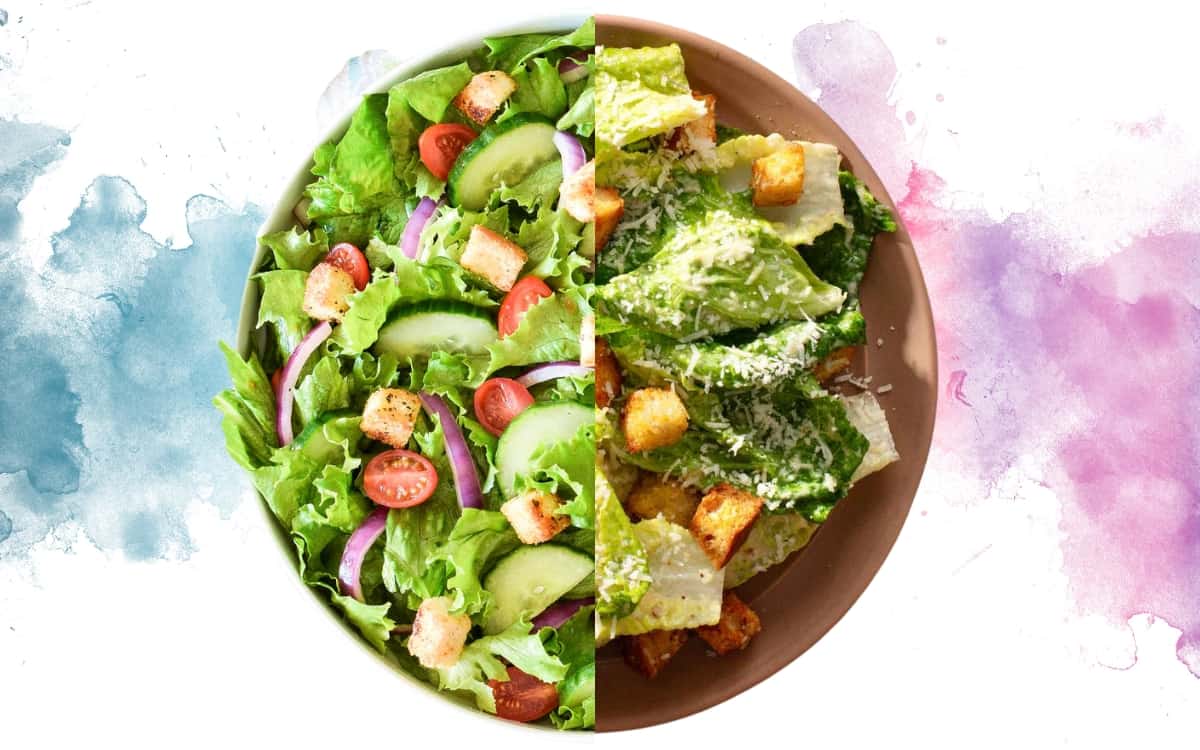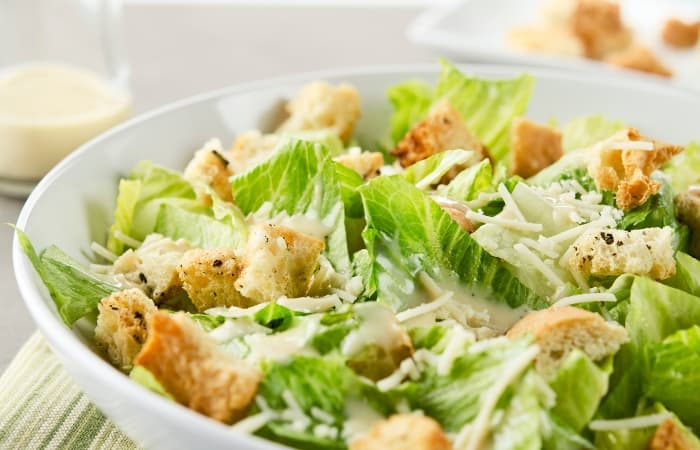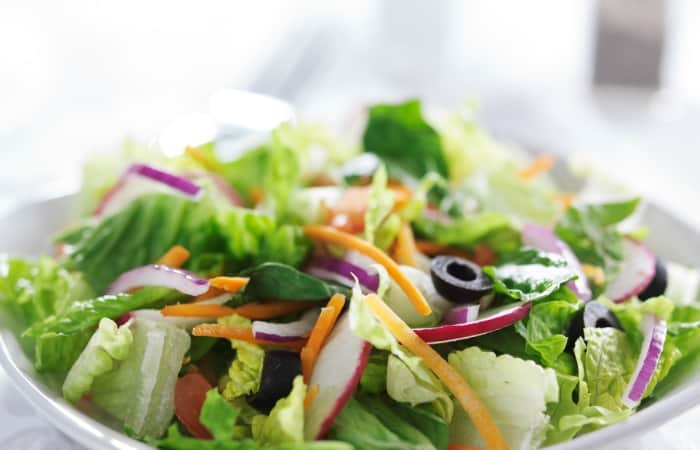When it comes to salads, there are a lot of options out there. Two of the most popular salads are Caesar salad and garden salad. Caesar salad is known for its creamy dressing and crunchy croutons, while garden salad is loaded with fresh veggies and a variety of toppings. In this blog post, we’ll be comparing these two salads to help you decide which one is the best choice for your next meal.

Compare Taste and Flavor
When it comes to taste and flavor, Caesar salad and garden salad have distinct differences. Caesar salad has a bold and savory taste due to the presence of anchovy paste and parmesan cheese. The creamy texture of the dressing along with the crispy texture of the croutons also adds to the flavor profile. On the other hand, garden salad has a lighter and more refreshing taste, mainly due to the inclusion of fresh vegetables and light dressing.
The taste and flavor of both salads can be influenced by various factors such as the freshness and quality of the ingredients used, the type of lettuce or greens used, and the dressing. Variations and additions to the salads can also impact the taste and flavor. For example, some popular variations of Caesar salad include adding grilled chicken, shrimp or bacon, while garden salad can be customized by adding fruits like berries or nuts like almonds.
Ultimately, taste and flavor are subjective and it depends on individual preferences. Some people may prefer the bold and savory taste of Caesar salad, while others may prefer the lighter and fresher taste of garden salad.
Compare Health Benefits
When it comes to health benefits, both Caesar salad and garden salad have their own advantages. Caesar salad is a good source of protein, fiber, and vitamins, thanks to the Romaine lettuce, croutons, and Parmesan cheese. The dressing, which is usually made with olive oil, provides healthy fats that can help lower bad cholesterol levels and reduce the risk of heart disease.
On the other hand, garden salad is a nutrient powerhouse, providing a wide range of vitamins and minerals from the various vegetables used in the salad. Leafy greens such as spinach, kale, and arugula are high in antioxidants and are excellent sources of vitamins A and C. Other vegetables such as carrots, cucumbers, and bell peppers also provide a variety of nutrients that can help support overall health.
Overall, both salads can contribute to a healthy diet when consumed in moderation and with a variety of other foods.
Compare Potential Health Risks
While both Caesar and garden salads are generally considered healthy options, there are some potential health risks to keep in mind.
Caesar salad, in particular, can be high in calories and fat due to the dressing and cheese. The traditional Caesar dressing contains raw egg yolks, which can increase the risk of foodborne illness. Additionally, some restaurants may use a pre-made dressing that contains added sugars, artificial flavors, and preservatives, which can undermine the health benefits of the salad.

Garden salad, on the other hand, may contain harmful bacteria if the vegetables are not properly washed or if the salad has been sitting out for too long. In addition, some salad dressings can be high in calories, fat, and sodium, which can contribute to health problems if consumed in excess.
It is important to take precautions when consuming both types of salads, such as ensuring that the vegetables are properly washed and that the dressings are made with healthy ingredients.
Compare Environmental Impact
The environmental impact of Caesar and garden salads can vary depending on how the ingredients are grown and produced.
Romaine lettuce, one of the main ingredients in Caesar salad, is often grown using large amounts of water and pesticides. The production of Parmesan cheese can also have a high carbon footprint due to the energy used in the production process. Additionally, the transportation of these ingredients from farms to restaurants can contribute to greenhouse gas emissions.
Garden salads, on the other hand, can have a lower environmental impact if the vegetables are grown using sustainable farming practices. Locally grown vegetables can also reduce the carbon footprint of the salad by reducing the distance that the ingredients need to travel. Additionally, choosing organic produce can reduce the use of pesticides and other harmful chemicals in the production process.
Cost Comparison
When it comes to cost, Caesar and garden salads can vary depending on the ingredients used and where they are purchased.
Caesar salads can be more expensive due to the cost of the Parmesan cheese and the croutons, as well as the price of a high-quality dressing. However, it is also possible to make a simple Caesar salad at home using affordable ingredients such as Romaine lettuce, a homemade dressing, and homemade croutons.
Garden salads can be more affordable, especially if the vegetables are purchased in season and locally. However, the cost of the salad can also vary depending on the type of vegetables used and the dressing.
Tips for making the salads more affordable include buying vegetables in bulk, using leftovers in the salad, and making homemade dressings and croutons.

What Are Some Variations of Caesar Salad and Garden Salad?
There are many variations of Caesar Salad and Garden Salad that you can try. Here are a few examples:
Variations of Caesar Salad
- Grilled Chicken Caesar Salad
- Shrimp Caesar Salad
- Steak Caesar Salad
- Vegan Caesar Salad made with a dairy-free dressing and no animal products
- Caesar Salad Wrap
- Caesar Salad Pizza
- Caesar Salad with Avocado
Variations of Garden Salad
- Greek Salad with Feta Cheese and Kalamata Olives
- Cobb Salad with Bacon, Egg, and Avocado
- Spinach Salad with Strawberries and Goat Cheese
- Caprese Salad with Fresh Mozzarella, Tomatoes, and Basil
- Waldorf Salad with Apples, Grapes, and Walnuts
- Nicoise Salad with Tuna, Green Beans, and Hard-Boiled Eggs
- Mediterranean Salad with Hummus, Olives, and Feta Cheese
These are just a few examples of the many variations you can make with Caesar Salad and Garden Salad. You can always experiment with different ingredients and dressings to create your own unique salad recipes.
What Are Some Common Dressings Used for Caesar Salad and Garden Salad?
The most common dressing used for Caesar Salad is Caesar dressing, which is typically made with ingredients such as olive oil, garlic, anchovy paste, Parmesan cheese, lemon juice, and Dijon mustard. However, there are also many variations of Caesar dressing, including vegan and low-fat options.
As for Garden Salad, there are many dressing options to choose from depending on personal preference. Here are some of the most common dressings used for Garden Salad:
- Balsamic Vinaigrette – made with balsamic vinegar, olive oil, and Dijon mustard.
- Ranch Dressing – made with buttermilk, sour cream, mayonnaise, and a blend of herbs and spices.
- Italian Dressing – made with olive oil, vinegar, and Italian herbs and spices.
- Honey Mustard Dressing – made with honey, Dijon mustard, vinegar, and olive oil.
- Thousand Island Dressing – made with mayonnaise, ketchup, sweet pickle relish, and vinegar.
- Blue Cheese Dressing – made with crumbled blue cheese, sour cream, mayonnaise, and buttermilk.
Of course, you can always experiment with different dressings and create your own unique flavor combinations.
Are There Any Cultural or Regional Differences in The Way Caesar Salad and Garden Salad Are Prepared or Consumed?
Yes, there can be cultural or regional differences in the way Caesar Salad and Garden Salad are prepared or consumed.

For example, in Italy, where the Caesar Salad originated from, it is common to use anchovies in the dressing, which may not be as popular in other parts of the world. In the United States, Caesar Salad is often served as a main course with grilled chicken or shrimp, while in Italy, it is usually served as a side dish.
Similarly, there can be regional variations in the preparation and consumption of Garden Salad. In the United States, for example, a typical Garden Salad might include lettuce, tomatoes, cucumbers, carrots, and croutons, while in Europe, a garden salad might include different greens and vegetables, such as arugula, radicchio, and fennel.
Cultural and regional differences can also influence the type of dressing used on these salads. In France, for example, it is common to dress a salad with a simple vinaigrette made from olive oil, vinegar, and Dijon mustard, while in the United States, creamy dressings such as ranch and blue cheese are often preferred.
Overall, the way Caesar Salad and Garden Salad are prepared and consumed can vary depending on the cultural and regional influences in a particular area.
Conclusion
In conclusion, both Caesar and garden salads have their own unique characteristics and can be enjoyed as part of a healthy diet. While Caesar salad may be higher in calories and fat, it provides a good source of protein and healthy fats. Garden salad, on the other hand, is a nutrient powerhouse and can provide a variety of vitamins




